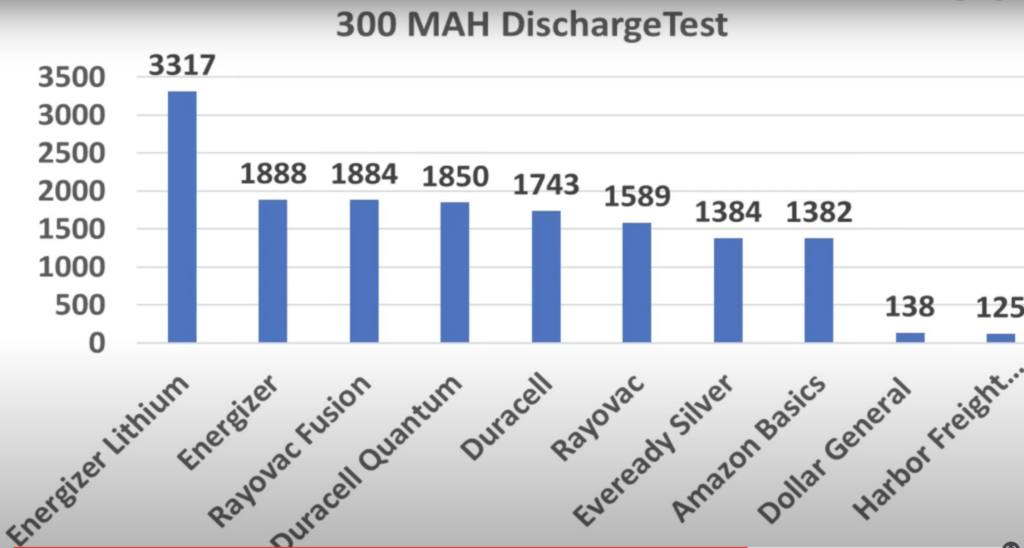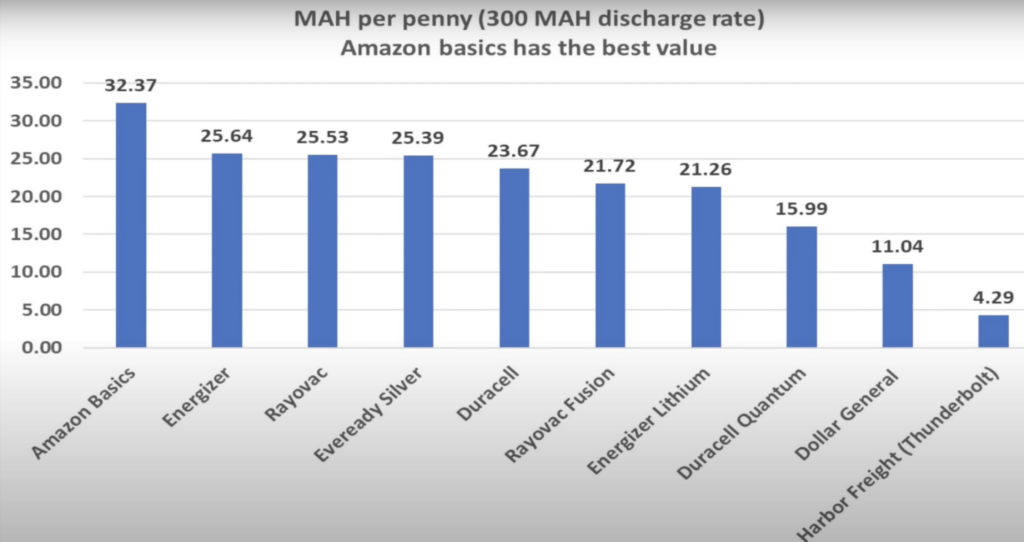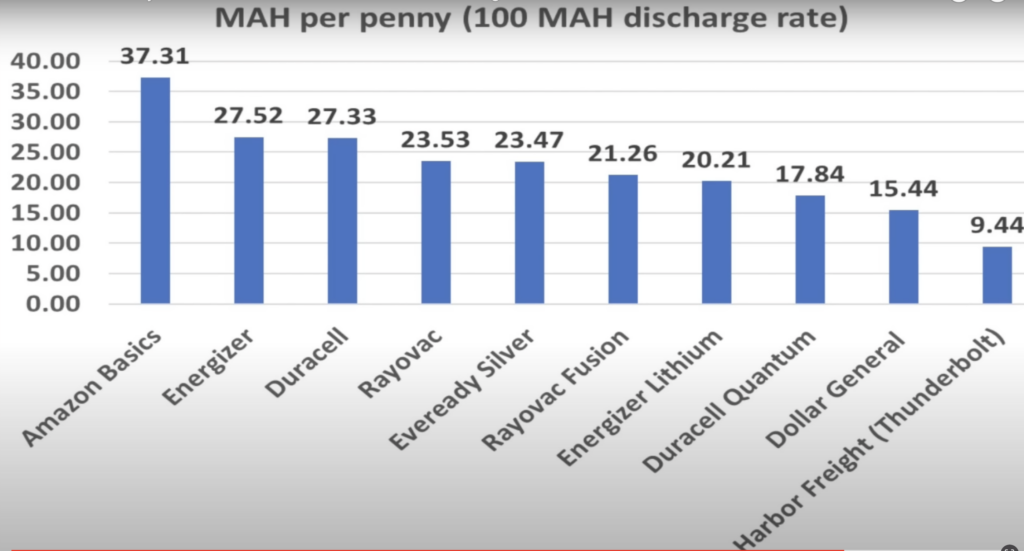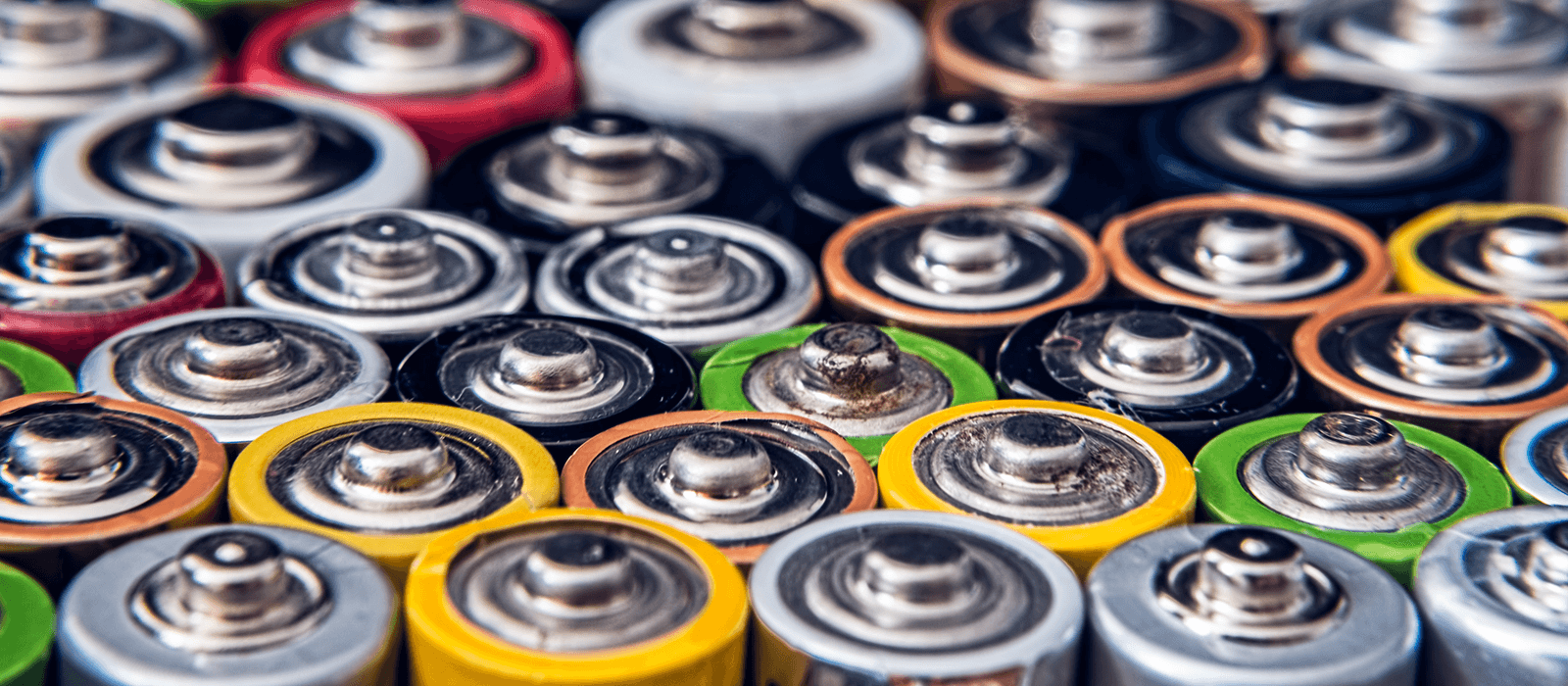The batteries tested include the Duracell, Energizer, Amazon Basics, Harbor Freight Thunderbolt, Duracell Quantum, Dollar Store, Rayovac, Eveready, and Energizer Lithium.
As one of the most commonly used types of batteries, AA batteries are a staple in households worldwide. AmazonBasics, Energizer, Duracell Quantum, Duracell, Rayovac, Energizer Lithium, and Eveready are among the most well-known brands for AA batteries. This review will examine these brands and evaluate their performance, reliability, and overall value for money.
AmazonBasics AA Batteries:
AmazonBasics is Amazon’s brand of batteries, and AA batteries are known for their affordable price and reliable performance. They come in a pack of 48 or 100 and are claimed to have a long shelf life of up to 10 years. They are rated at 1.5 volts and ideal for low-to-moderate power usages, such as TV remote controls, gaming controllers, and flashlights. However, they may not last as long as some more expensive brands when used in high-drain devices such as digital cameras or electronic toys.
Energizer AA Batteries:
Energizer AA Batteries is a well-known brand that has been producing batteries for over a century. Their AA batteries come in packs of 20, 24, or 48 and are rated at 1.5 volts. Energizer batteries are known for their long-lasting power and reliability, ideal for high-drain devices such as digital cameras, toys, and gaming controllers. They also have a shelf life of up to 10 years, making them a reliable choice for emergency kits and other long-term storage needs.
Duracell Quantum AA Batteries:
Duracell Quantum is Duracell’s top-of-the-line battery brand. Their AA batteries come in packs of 4, 6, 8, or 12 and are rated at 1.5 volts. Duracell Quantum batteries are claimed to last longer than other Duracell batteries and have a unique power-boosting technology that delivers more power to high-drain devices. They also have a 10-year shelf life and are ideal for high-tech devices such as digital cameras, electronic toys, and other power-hungry devices.
Duracell AA Batteries:
Duracell is a well-known brand producing batteries for over 90 years. Their AA batteries come in packs of 4, 8, 16, 24, or 48 and are rated at 1.5 volts. Duracell batteries are known for their reliable performance and long-lasting power, making them ideal for various devices, including TV remote controls, flashlights, and gaming controllers. They also have a long shelf life of up to 10 years.
Rayovac AA Batteries:
Rayovac is a budget-friendly battery brand offering good performance and value. Their AA batteries come in packs of 4, 12, 18, 24, or 48 and are rated at 1.5 volts. Rayovac batteries are ideal for low-to-moderate power usage and for devices such as TV remote controls, flashlights, and small toys. However, they may not perform as well as some more expensive brands when used in high-drain devices such as digital cameras or gaming controllers.
Energizer Lithium AA Batteries:
Energizer Lithium AA batteries are known for their exceptional performance in high-drain devices. They come in packs of 4, 8, or 12 and are rated at 1.5 volts. Energizer Lithium batteries are claimed to last up to 8 times longer than standard alkaline batteries and have a shelf life of up to 20 years.
So, when it comes to double A batteries, there’s no shortage of marketing hype, and I’ve had many people ask me to test double A batteries, so that’s what we’re going to do today.
I don’t know about you, but I use double-A batteries for many different things, including even the microphone on the camera I’m using right now.
I spend a lot of money on double A batteries, and I want to know if it’s worth paying more for batteries or if I’m better off just buying a less expensive product.
For example, you could buy five-dollar general store batteries for the price of one Energizer battery, so is an Energizer that much better than the competition?
Well, I don’t know if they are not, but we’re about to find out, so let’s get the testing underway.
Before we begin testing batteries, there’s a clever trick I learned about that does work: the bounce test. Now the purpose of this test is to determine whether or not a battery is used.
Now it won’t let you know whether or not the battery is used up, but it’ll give you a pretty good idea as to where the battery is regarding the charge.
The more it bounces, the less energy it has in it. Now, this works because if you drop a brand-new battery on end, it will bounce less, but if you take a used battery.
In this case, I have two batteries that are used up. There’s a dark line on them; dropping them on the opposing end will bounce slightly.
I won’t get into all the sinuses of why this happens, there is a reason for it, and that’s pretty interesting, but we’re going to see how this bouncing works.
The new Duracell is at 1.61 Volt. The ones that are used up are at 1.22 Volt and 1.20 Volt going to see how it does against the new one on the drop test to determine which battery lasts longest.
We need some technology to measure how much energy is in each battery, and that’s precisely what the battery charger I purchased could do.
I’m not endorsing this brand Opus BT-C2000-charger-set. I don’t do any sponsorship deals. Again, I purchased this with money. So how does this battery charger work?
Well, It has a mode for discharging batteries. In other words, it will drain each battery’s energy and measure how much energy it pulls out of each battery.
While doing so, it has several different discharge rates. So we will do more than one battery. We’ll do a couple of batteries, and we’re also going to use a couple of different settings.
So, let’s begin the testing by comparing dollar general heavy-duty batteries against the Duracells. I bought these for a dollar. These were relatively expensive, so eight batters for dollars is 13 cents each.
We’ll see how they compare to the Duracell. I will set this up to discharge at 300 milliamps. So this is very interesting. Right now, it’s showing us what’s happening on the first battery at eight minutes.
It has less than one-volt, 0.99 to be precise. Battery two is at nine minutes. It has 0.95 volts. Battery three is at nine minutes, 1.34 volts so far; the Duracell is outperforming the dollar general store significantly, a big difference.
It’s the same with the fourth battery, 1.34 volts, so the Duracell batteries are doing very well. These dollar general store batteries are about to die. So the dollar general store batteries did not do well at all, only lasting 26 minutes and producing 117 milliamp hours for the first battery in 35 minutes and 158 milliamp hours for the second battery.
Not nearly as good as the Duracell, which lasted 381 minutes, producing 1747 milliamp hours. The second battery lasted 380 minutes, producing 1738 milliamp hours.
To make this more interesting, I will try one battery for each brand for the next test.
We’re about to mix things up a bit. The Rayovac fusion and a Duracell quantum claim that no alkaline battery lasts longer.
They both can’t be right, so let’s see which is better. We’re also going to test the Amazon Basics, as well as a harbor freight thunderbolt.
– 5 hours later –
The Amazon Basics did pretty well, considering the price of the battery; it produced 1382 milliamp hours and lasted 301 minutes. Now the Duracell quantum produced 1850 milliamp hours and lasted 405 minutes.
Unfortunately for the Duracell, the Rayovac fusion lasted longer, producing 1884 milliamps hours and 410 minutes.
However, both finished in a tie. Unfortunately, the harbor freight thunderbolt didn’t do too well. Just like the dollar general store only lasted 28 minutes and produced 125 milliamp hours. That’s worse than the dollar store battery.
So are our lithium batteries worth the extra cost?
These Energizer lithium batteries are about $1.50 each, costly compared to a $0.55 for an Eveready, or a $0.75 Energizer or around a 70-cent Rayovac.
– 6 hours later –
So is the Energizer better than Duracell? We’re about to find out. First, the Rayovac lasted 347 minutes and produced 1589 milliamps hours. The Eveready lasted 303 minutes and produced 1384 milliamp hours.
The Energizer beat the regular Duracell as well as a Duracell quantum and all the other batteries we’ve tested up to this point, lasting 411 minutes and producing 1888 milliamp hours which is very impressive.
However, not surprisingly, the Energizer lithium beat all the batteries by a long shot lasting 723 minutes and creating 3317 milliamps hours. So next, we will slow down the battery drain interval to only 100 milliamp hours.
So, Harbor Freight’s Thunderbolt only lasted 181 minutes and produced 275 milliamp hours; dollar general could have done better than Harbor Freight; unfortunately, it only lasted 128 minutes and produced 193 milliamp hours.
The Eveready, on the other hand, lasted 837 minutes and produced 1279 milliamp hours. The Rayovac lasted 1205 minutes and made 1844 milliamp hours.
The Duracell Quantum lasted 1 363 minutes and made 2064 milliamp hours; the Duracell lasted 1315 minutes and made 2012 milliamp hours.
And the Energizer lasted 1329 minutes and made 2026 milliamp hours, in second place behind the Duracell Quantum.
Up next would repeat the test on Amazon basics, I made a mistake on that test, and I’m also going to test the Energizer lithium and the Rayovac.
The Amazon Basics battery lasted 1043 minutes, producing 1593 millivolt hours. The Energizer Lithium lasted twice as long as the competition for 2081 minutes and produced 3152 milliamp hours. The Rayovac only lasted 958 minutes, producing 1465 milliamp hours, which is not even as good as the Amazon Basics.

The 300-milliamp discharge rate is a reasonably quick drain. The Energizer Lithium demonstrated that it is far better than any alkaline batteries we tested.
I’m impressed with the Energizer beating the regular Duracell and the Duracell Quantum.
While the Amazon basics finished near the bottom of the competition, the price of the battery makes it the best value of the batteries we tested.
The Amazon Basics produced over 32 milliamps of energy for one penny compared to the next closest competitor, the Energizer, which made nearly 26 milliamps for a penny.
While the Energizer lithium was the best battery, it’s not the best value. Finally, the worst value included the Dollar General and the Harbor Freight Thunderbolt. Both drain your wallet more than the competition.

As expected for the 100-milliamp discharge test, the Energizer Lithium’s battery easily beat the alkaline batteries, and the Duracell quantum barely beat the Energizer.
The Amazon Basics did well considering the price finishing ahead of the Rayovac and the Eveready Silver, both more expensive batteries.
Just as before, the Dollar General and the Harbor Freight Thunderbolt could have done better.

Once again, the Amazon basics came out on top, making 37 milliamps per penny, and the Energizer held onto its second-place position making nearly 28 milliamps per penny.
Once again, the dollar general and the Thunderbolt batteries finished in the last two positions, demonstrating that they aren’t a good value.
So which brand do you like the best, and which ones do you usually buy? Did you enjoy the test if you did? I want your opinion on whether or not I should do an AAA battery showdown.
Also, what about rechargeable batteries? Do you use rechargeable batteries, and would you like me to put together a showdown on those as well?
Regarding my opinion on these batteries, I was impressed with the Amazon Basics; I didn’t think it would do so well compared to the competition.
It should finish closer to the harbor freight or the dollar general, given the price of the battery is very affordable.
So which battery would I buy?
I would buy the Energizer because it balances price and energy production well.
Now the Energizer Lithium is too expensive for the energy it produces, but it is a good battery.
In some applications, I might buy the lithium but not for a camera, microphone, or something else that doesn’t have a significant amount of battery drain.
I was disappointed with the Harbor Freight Thunderbolt and the dollar general; they seem to be draining your wallet.
They are not giving you a good product, so I only recommend them as a battery if you’re trying to buy something for a kid’s toy that makes noise and wants it to stop quickly.
That might be the only time I would buy double a battery for those.
Anyway, I want to say thanks so much for reading the test; I really look forward to reading your test ideas, so please give me some ideas for future tests; please take care, and I look forward to next time.


Leave a Reply